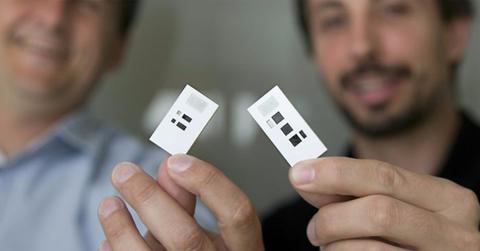These Paper Fuel Cells Are Way Cheaper And Greener Than Regular Batteries
A paper-based battery created by Fuelium generates energy from liquid samples, and it could be a new way to power single-use diagnostic tests.
Updated May 18 2019, 7:32 p.m. ET

Many disposable diagnostic devices, often used for pregnancy tests and glucose level monitoring, contain a small lithium battery. Only one percent of that charge is used before the item is tossed away. While batteries are small in size, their impact on the environment can be significant. That's why Juan Pablo Esquivel created a new paper battery, Fuelium.
Since beginning his career at the Monterrey Institute of Technology in Mexico, Esquivel has wanted to make things cheaper and easier. He’s been working with fuel cells, similar to the technology used in some electric cars, but on a much smaller scale. It led to the development of paper-based batteries and finding the perfect opportunity to use them.
Instead of using a traditional lithium battery, intertwining sensors and displays with paper as a base material created a self-powering system when a chemical reaction occurs. That development led to the founding Fuelium in 2015. Single-use in-vitro diagnostics (IVD) applications, such as portable diagnostic tests, became an ideal match for the technology.
In order for fuel cells to function, energy produced by an electrochemical reaction is converted into usable electricity. Bodily fluids used in these tests would provide the reaction needed to spark that power. Other examples of potential use would be to find infectious diseases, determining blood-alcohol levels, and veterinary care.

There’s a number of immediate benefits from Fuelium’s paper-based batteries. When thrown away, these have far less of a negative impact on the environment. Esquivel tells OZY that these “small, non-toxic, inexpensive fuel cells and batteries” can “be thrown away with no ecological impact.” The vast majority of lithium-ion batteries contain superhalogens, which are toxic, but creating them with halogen-free electrolytes is now a possibility.
Only the energy that’s needed is generated, which eliminates the massive waste from lithium batteries. While they are very small, roughly 99 percent of lithium battery energy is wasted on these single-use applications. It’s also cheaper to produce, meaning the reach of these diagnostic tests can extend to developing countries.
Similar technology has also been developed by Seokheun Choi, a computer science assistant at Binghamton University. He’s used bacteria from dirty water to transfer electrons and generate energy. Last August, he demonstrated a paper battery that powered on an LED light with a single drop of saliva.
According to OZY, Fuelium now has a group of five workers on staff and they've signed off on their first contract. While it’s still getting off the ground and it won’t be powering vehicles anytime soon, this technology is very promising in the telemedicine industry.